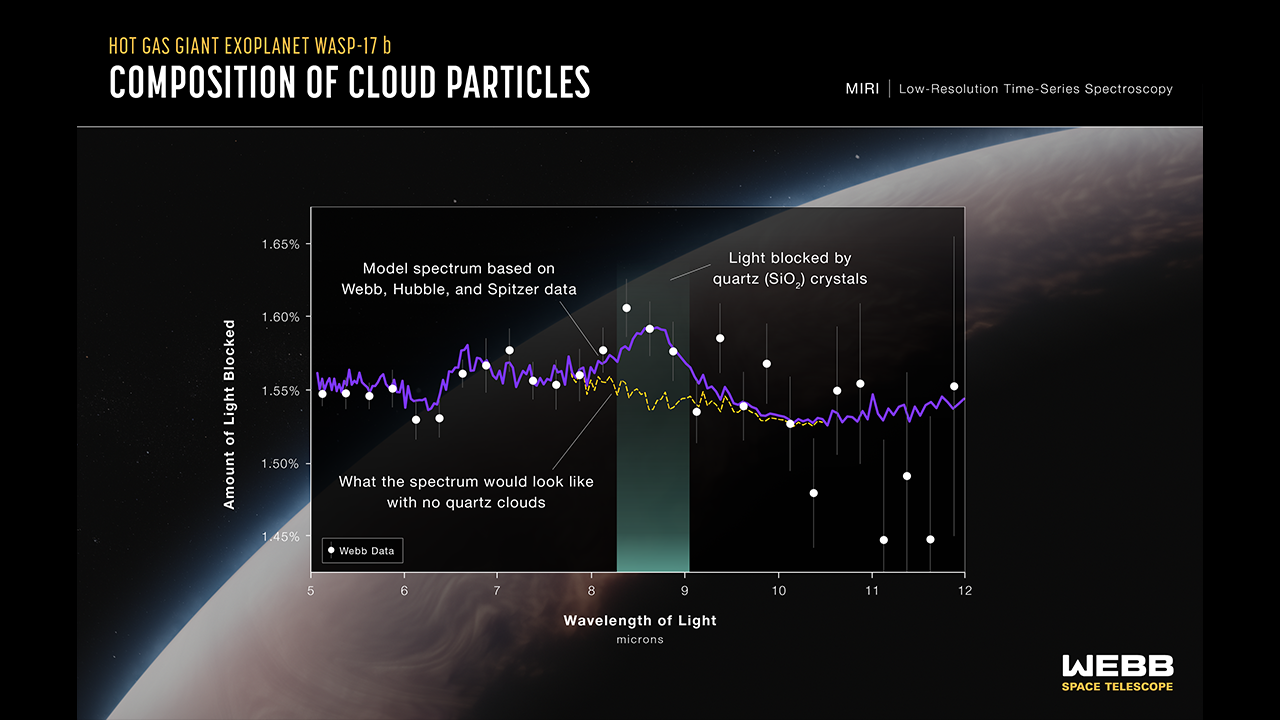High in the atmosphere of WASP-17b are clouds of tiny quartz particles, like minuscule grains of sand. The discovery is proof of the capacity of the JWST to probe the composition of distant planets – in this case, one 1,300 light years away. It’s also a great reminder of how good we have it on Earth.
One of the JWST’s priorities is probing the atmospheres of planets orbiting other stars. Gas giants make easier targets than rocky planets like our own. For one thing, they have a lot more atmosphere to alter the incoming starlight. Favored targets are generally so-called “hot Jupiters” that orbit so close to their stars we can see them crossing frequently.
WASP-17b, also known as Ditsö̀, certainly fits the bill. It has a mass just over half that of Jupiter, but a radius almost double, a consequence of the expansion produced by its 1,550 K (2,800 °F) temperatures. Ever since its discovery in 2009 as one of the early exoplanet discoveries, we’ve known WASP-17b is truly extreme, but had to wait (and wait and wait) for the JWST to know more.
“We were thrilled!” said Dr David Grant of the University of Bristol in a statement. “We knew from Hubble Observations that there must be aerosols – tiny particles making up clouds or haze – in WASP-17 b’s atmosphere, but we didn’t expect them to be made of quartz.”
Quartz is silicon dioxide, made up of the two most common elements in Earth’s crust, so their presence on other worlds is to be expected. However, previous extremely hot planets have been found to have silicates high in magnesium such as olivine, not quartz as pure as the finest beach.
Nevertheless, when Grant and colleagues compared the light filtered by WASP-17b’s atmosphere with that direct from WASP-17, the major difference was at a wavelength of 8.6 microns, consistent with pure quartz.
The spectrum from WASP-17, subtracting what is detected when it passes through the planet’s atmosphere to identify the molecules present
Image Credit: NASA, ESA, CSA, Ralf Crawford (STScI)
“We fully expected to see magnesium silicates,” said Dr Hannah Wakeford. “But what we’re seeing instead are likely the building blocks of those, the tiny ‘seed’ particles needed to form the larger silicate grains we detect in cooler exoplanets and brown dwarfs.”
Based on scattering observations previously made using Hubble, the grains are thought to be about 10 nanometers (0.0000004 inches) across, making them too small to inspire even the most devoted believer in the power of crystals.
Although primarily hydrogen and helium, WASP-17b is so hot it contains silicon dioxide gas, which condenses to microscopic crystals at high altitudes where the atmosphere is thin. However, the planet is almost certainly tidally locked, with one permanently star-facing and one night-facing side. The crystals are forming crowds at the twilight boundary, the region we can study, and we can’t tell how far they extend beyond this region. Grant noted; “The winds could be moving these tiny glassy particles around at thousands of miles per hour.”
The discovery of a planet with less than half the density of Saturn orbiting a red dwarf stunned astronomers, who compared it to a marshmallow – WASP-17b’s density is 2-3 times lower still, possibly just 8 percent that of water, but it orbits an F6 star some 20 percent more massive than the Sun. Consequently, in this case, we have a better understanding of why this is the case. WASP-17b has a quite elongated orbit which, given how close it gets to its star, causes immense tidal flexing. It is thought this puffs up its interior while radiation expands its outer layers.
WASP-17b is one of the very few known planets orbiting in the opposite direction to its star’s spin, indicating something very odd about its history.
The discovery is open access in The Astrophysical Journal Letters.
Source Link: JWST Detects Tiny Quartz Crystals In A Distant Hot Jupiter’s Atmosphere
